
Cleaning Up after Dirty Disinformation Tricks
“Falsehood flies…and the Truth comes limping after it,” wrote Jonathan Swift the Anglo-Irish writer and satirist in 1710. That was in the 18th century of course. Now in the 21st century, with the advent of the Internet, distribution platforms, and new technologies such as bots and deepfakes, the truth cannot even begin to keep up. According to a 2019 study published in Science by the MIT Media Lab, falsehoods are 70% more likely to be retweeted on Twitter than the truth, and reach their first 1,500 people six times faster.
So how DO you fight disinformation? Can you provide an alternative view – this time, a fact-based one in such a way so as to not only to educate people but also dissuade them from going down the rabbit hole of falsehoods and conspiracy theories? And if so, how effective can you be?
Guest Debra Lavoy is a technologist turned marketing strategist who sees disinformation campaigns as a malicious application of narrative and digital marketing tools. Tune in to hear a lively discussion of how effective it is to change the ratio of good to garbage on people’s social media feeds and make it easier to tell the difference.
Hosted by: Alexa Raad & Leslie Daigle
Related material:
- Dr. Ralph Lewis in Psychology Today – “Why do People Believe Such strange Things” https://www.psychologytoday.com/us/blog/cutting-edge-leadership/202008/why-do-people-believe-strange-things
- The Reality Team https://www.realityteam.org
Podcast: Play in new window | Download
Subscribe: Apple Podcasts | Spotify | Android | Blubrry | RSS